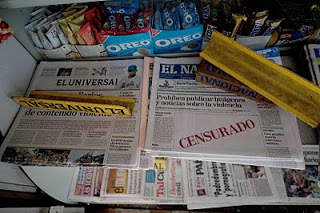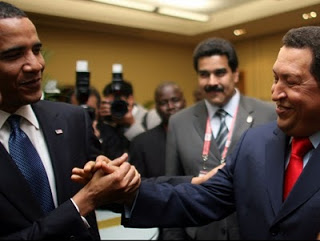
A graphic image published on the front page of a Venezuelan newspaper has sparked an international controversy over the limits of press freedom and journalistic ethics
Imagine you’re walking on the street with your children and you pass a newstand with today’s papers displayed as usual and the front pages clearly visible to all who pass by. But to your horror, today’s national daily has an almost full-page graphic image of dead, bloodied bodies piled on top of each other in the local morgue. Every newstand you walk by has the same image, even repeated in several national and local papers. Your children are forced to see this with no warning.
Such a horrifying image could be justified if it was taken last night after some atrocious event had occurred. But no, as it turns out, it’s a photograph taken last December, more than eight months ago, and is simply being used to make a political statement against crime. Furthermore, the photograph has no visible credits and, according to the morgue authorities, was taken in secrecy, unauthorized, and in clear violation of the privacy rights of the family members of the deceased.
Is this the kind of journalism society defends? When do media cross the limits into the grotesque, the pornographic and the obscene? Whose job is it to ensure viewers and readers are protected from such offensive and violent images? Is it only a question of journalistic ethics, or is it a larger issue of values, privacy rights and fundamental well being?
POLITICAL AGENDAS
These are the issues Venezuela is grappling with after the publication of a graphic image, as described above, in the daily paper, El Nacional. The image was then republished in another national daily, Tal Cual, along with several regional newspapers.
El Nacional editor and owner, Miguel Henrique Otero, admitted the image was taken “unauthorized” last December in the Caracas morgue, and said he “held off from publishing it because of its graphic content” until the “right moment”. Venezuela is one month away from critical legislative elections, and Otero forms part of an extremist opposition organization, “2D”, supporting opposition candidates to the National Assembly. Otero makes no effort to hide his “anti-Chavez” opinions in his newspaper, one of the two main national dailies.
In an interview on CNN en Español with Otero, the US news network admitted the image published by El Nacional was too graphic to present to viewers and stated, “CNN will not show this image during any of our broadcasts since we consider it could perturbe viewers and is too graphic to show”. Nonetheless, Otero, and other corporate media in Venezuela, claim the publication of the graphic image is a part of “free expression”.
But Otero did admit during the interview on CNN that he decided to publish the 8-month old photo last Friday because Venezuela is “one month away from elections” and “we are in campaign mode”, thereby admitting the publication of the photo was a political act, and not merely an expression of press freedom.
So, the question then arises, are there limits to media’s power? If so, what are they and who decides what they are?
PUBLIC OUTCRY
Venezuelans reacted largely critical regarding the publication of the graphic photo in El Nacional. A group of concerned citizens protested on Tuesday before the Attorney General’s office, demanding children be protected from such violent images. Litbell Diaz, President of the National Institute for the Rights of Children and Adolescents (Idena), declared to the press, “Whoever published that photograph knew those types of images affect children, but their intention was to destabilize, and it was done with premeditation”.
Diaz and several dozen representatives from Idena, along with hundreds of children and adolescents, requested the Public Prosecutor’s office open a criminal investigation into the publication of the photograph by El Nacional.
On Tuesday afternoon, Venezuela’s Mediation Court for the Protection of Children and Youth in Caracas ordered the prohibition of “images, information and publicity of any kind, with bloody content or messages of terror, physical aggresion, or images that use war content or messages of deaths and deceased that could alter the psychological well being of children and youth”. This is the first time in Venezuela that the judiciary has taken a stance on print media content. The decision also ordered El Nacional to cease publication of such images based on an “Order of Protection” requested by the Public Prosecutor’s office. The national daily Tal Cual was also subject to the restraining order, which was issued for a one-month period while investigations continue.
The judicial decision caused national responses.
Opposition candidate to the National Assembly, Delsa Solorzano, declared during an interview on Wednesday that “pornographic magazines are sold in newstands” so therefore, “children are already vulnerable” to such images. What Solorzano failed to mention is that pornographic material is not fully viewable in newstands and is placed “out of reach” for children. On the other hand, the El Nacional front page was displayed prominently in newstands and shops nationwide.
Forensic doctors working at the Caracas morgue publicly repudiated the publication of the graphic image in El Nacional claiming it was an “aggression” against their profession and workplace. “This is not an easy job, and we do not agree that the [press] manipulate us. We demand respect and ask you allow us to do our jobs in peace”, said Carmen Julieta Centeno, National Coordinator of Forensic Scientists of the CICPC (Venezuela’s Forensic Police).
For his part, President Chavez called the publication of the 8-month old violent image a sign of “desperation” on behalf of the opposition. “The country demands respect…The publication of this image just shows desperation, because they are trying to sabotage the Bolivarian Revolution by any means”.
“The opposition have been working on a mix of plans, so that by today we would have been in a state of chaos in the country”, said Chavez, adding, “Nonetheless, it seems as though their plans haven’t worked and they are desperate now, so they are trying to generate reactions from the people”.
But journalist Alberto Nolia, who hosts en evening program on Venezuelan state television that harshly criticizes the opposition, declared the court’s decision “absurd”. While considering the publication of the image in El Nacional “yellow journalism”, Nolia also stated that “children are not stupid, they know what’s going on. Perhaps it would be better to publish images of people killed by violent crime with explanations about who they were and the fact that now their lives are over, so that kids will understand the severity of delinquency”.
“Neither children nor anyone should be protected from learning of the violence of our societies”, declared Nolia, adding that “the problem of crime in Venezuela is very serious”.
MEDIA LIMITS
Earlier this year, US media struggled with the publication of graphic images from Haiti’s tragic earthquake. In a National Public Radio (NPR) discussion titled “What’s Too Graphic? How to Photograph Disaster”, most journalists agreed that it was essential to weigh the public value and use of the images or information versus family privacy and violent impact.
“Photographs have the power to impact people at a visceral level and change the hearts and minds of public opinion and national focus”, said Kenneth Irby, Director of the Visual Journalism Group at the Poynter Institute for Media Studies. “There’s an awful lot of censorship that happens both in terms of military and governmental activites in America (US) in particular”, he added, referring to Pentagon controls over the publication of images of US soldiers killed in battle.
In the US, a country that strongly lauds itself for press freedom standards, freedom of expression is not absolute under the First Amendment. Privacy rights often supersede press freedoms. According to US Tort Law, “material may be published so long as it is legally obtained, not offensive to a reasonable person and of legitimate public concern”.
But who makes such determinations?
Today, the Pentagon is hunting down the founders of the website, Wikileaks.com, because of the publication of thousands of classified US government documents. Wikileaks claims the publication is in the “public interest”, but the Pentagon says it’s harmful to “private interests”. Who is right and who is wrong?
As media grow stronger and gain more power and influence over our societies, these issues will become more prominent in our every day lives. At some stage it will be necessary to stop considering all journalists and corporate media outlets as “proveyers of the truth” and start to look critically at the interests and agendas those powerful corporations represent.
Last month, declassified documents from the US Department of State evidenced millions of dollars in funding to Venezuelan media groups and journalists, to "foster freedom of expression and press" and to ensure favorable reporting on issues of interest to the US government.
T/ Eva Golinger
